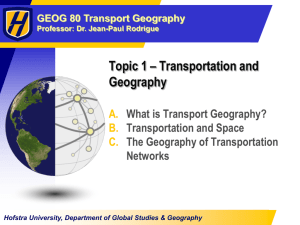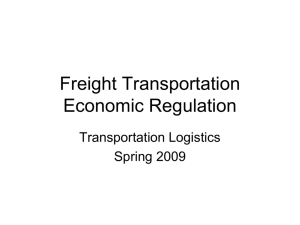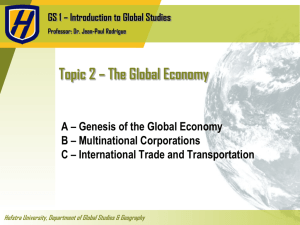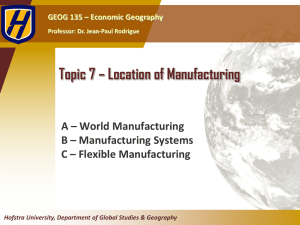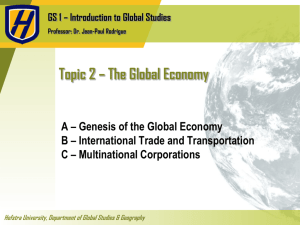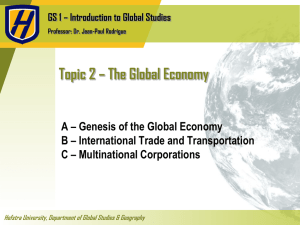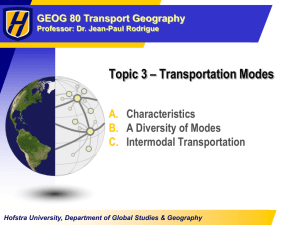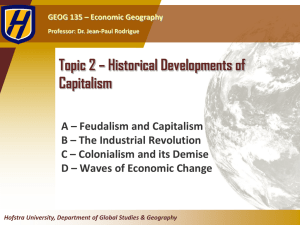Topic 5 * Migration and Health
advertisement
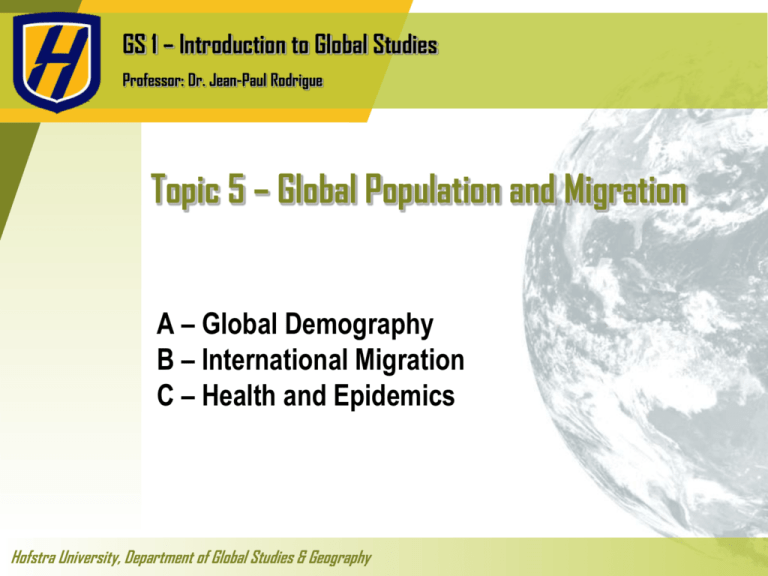
GS 1 – Introduction to Global Studies Professor: Dr. Jean-Paul Rodrigue Topic 5 – Global Population and Migration A – Global Demography B – International Migration C – Health and Epidemics Hofstra University, Department of Global Studies & Geography A – GLOBAL DEMOGRAPHY Demographic History Population Trends Demographic Transition Population Distribution © Dr. Jean-Paul Rodrigue World Population, 1000BC-2050AD (in billions) 10 9 8 Population “explosion” A process of strong demographic growth. Started after the Second World War. About 80 million people added each year. 7 6 5 4 3 2 1 0 -1000 -750 -500 -250 0 250 500 750 1000 1250 1500 1750 2000 © Dr. Jean-Paul Rodrigue Population Added to the Global Population, 1950-2010 (in millions per year) 100.0 2.5 90.0 80.0 2 1.5 Millions 60.0 50.0 40.0 1 Growth Rate (%) 70.0 30.0 20.0 0.5 10.0 Addition 2010 2007 2004 2001 1998 1995 1992 1989 1986 1983 1980 1977 1974 1971 1968 1965 1962 1959 1956 1953 0 1950 Growth Rate © Dr. Jean-Paul Rodrigue World Population 1804-2048 (in billions) 10 9 20 years 8 15 years 7 13 years 4 1959 37 years 2 1987 1974 15 years 3 0 1800 1999 12 years 5 2028 2012 13 years 6 1 2048 1922 118 years 1804 1850 1900 1950 2000 2050 © Dr. Jean-Paul Rodrigue Scenarios of Global Population Growth, 2009-2050 12.0 10.0 8.0 6.0 Reference Low High 4.0 2.0 0.0 © Dr. Jean-Paul Rodrigue World’s 15 Largest Countries, 2005, 2050 (in millions) Japan -18 128 Viet Nam 84 34 Philippines 83 44 Egypt 75 53 Mexico Congo, DR of 106 34 56 96 Ethiopia 74 Brazil 97 183 50 Bangladesh 153 102 Nigeria 130 128 Indonesia 225 Pakistan Growth (2005-2050) 68 161 United States 2005 188 300 109 China 1,330 India -200 75 1,097 0 200 400 600 435 800 1,000 1,200 1,400 1,600 © Dr. Jean-Paul Rodrigue Population Change between 2000 and 2050 (%) Italy Spain Russia Germany Netherlands Poland Britain Sweden France United States Ireland -30 -20 -10 0 10 20 30 © Dr. Jean-Paul Rodrigue Demographic Transition Theory Explain the demographic transition theory and its impacts on global population growth. Birth Rate Death Rate Total Population Phase I Phase II Phase III Phase IV © Dr. Jean-Paul Rodrigue Stages in Demographic Transition Stage I Stage II Stage III Stage IV High birth rates High birth rates Falling birth rates Low birth rates Family Planning. Lower infant mortality rates. Industrialization means less need for labor. Increased desire for material possessions and less desire for large families. Emancipation of women. Children as liabilities instead of assets (no economic contribution as labor). Low death rates Low death rates No or little Family Planning. Parents have many children because few survive. Many children are needed to work the land. Children are a sign of virility. Religious beliefs and cultural traditions encourage large families. High death rates Falling death rates Disease and plague (e.g. bubonic, cholera, kwashiorkor). Famine, uncertain food supplies and poor diet. Poor hygiene, no clean water or sewage disposal. Improved medicine. Improved sanitation and waters supply. Improvements in food production in terms of quality and quantity. Improved transport to move food. Decrease in child mortality. Modern medicine. Optimal life expectancy. © Dr. Jean-Paul Rodrigue Survivorship of the British Population, 17th and 20th Centuries 100 90 80 Survivorship 70 60 17th Century 50 1999 (M) 1999 (F) 40 30 20 10 0 0 5 10 15 20 25 30 35 40 45 Age 50 55 60 65 70 75 80 85 © Dr. Jean-Paul Rodrigue Crude Birth Rates, Western Europe, 1751-1991 45 40 35 30 25 20 15 Britain Ireland France Sweden Germany Italy 10 5 0 © Dr. Jean-Paul Rodrigue Crude Death Rates, Western Europe, 1751-1991 45 40 35 30 25 20 15 Britain Ireland France Sweden Germany Italy 10 5 0 © Dr. Jean-Paul Rodrigue Total Fertility Rate, Selected Units, 1950-2010 8 7 6 5 World 4 3 Europe North America China Africa India 2 1 0 © Dr. Jean-Paul Rodrigue Fertility Transition in some Countries, 1962-2007 8 7 6 TFR 5 4 3 2 1 0 1962 1982 1990 2000 2007 © Dr. Jean-Paul Rodrigue Share of Global Population per Continent, 1700-2000 100% 90% 80% 70% Oceania 60% 50% 40% 30% Asia Middle East CIS Africa Europe Latin America North America 20% 10% 0% © Dr. Jean-Paul Rodrigue Relationship Between Fertility and GDP per Capita, Selected Countries, 2007 With is the relationship between TFR and GDP and to what this relation may be attributed to? 9 8 Niger 7 Congo 6 Ethiopia Nigeria TFR 5 Kenya 4 Pakistan India 3 Egypt Bangladesh Indonesia 2 United States Mexico France Russia Germany Vietnam 1 China 0 200 Singapore Thailand 2000 South Korea Japan Hong Kong 20000 GPD per Capita © Dr. Jean-Paul Rodrigue 2.0 1.8 1.6 1.4 1.2 1.0 0.8 0.6 0.4 0.2 Aged 0-14 2050 2045 2040 2035 2030 2025 2020 2015 2010 2005 2000 1995 1990 1985 1980 1975 1970 1965 1960 1955 0.0 1950 Billions World Population by Age Group, 1950-2050 Aged +65 © Dr. Jean-Paul Rodrigue World Population Density and Distribution, 2005 To what factors may be attributable the distribution of the global population? Typical concentrations along major river systems. Areas of large concentrations: South Asia, East Asia, Western Europe, Northeastern North America. “Empty” areas are attributed to: harsh physical landscapes and harsh temperature. © Dr. Jean-Paul Rodrigue Essay: Global Demography Based upon the material seen in class, elaborate about the world’s major demographic challenges in the coming years. © Dr. Jean-Paul Rodrigue B – INTERNATIONAL MIGRATION Types of Migration Migration Patterns Brain Drain Migration Policy Refugees © Dr. Jean-Paul Rodrigue Types of Migration ■ Emigration and immigration A Problems or benefits? Emigrant • Change in residence. • Relative to origin and destination. ■ Requires information • People and conditions. • Two different places. • Two different times. ■ Duration Immigrant B Problems or benefits? • Permanent. • Seasonal / Temporary. ■ Choice / constraint • Improve one’s life. • Leave inconvenient / threatening conditions. © Dr. Jean-Paul Rodrigue Types of Migration Gross migration Immigration ■ Gross migration • Total number of people coming in and out of an area. • Level of population turnover. ■ Net Migration Emigration • Difference between immigration (inmigration) and emigration (outmigration). • Positive value: • More people coming in. • Population growth (44% of North America and 88% of Europe). • Negative value: • More people coming out. • Population decline. Net migration © Dr. Jean-Paul Rodrigue Net Migration, 2005-10 Read this content © Dr. Jean-Paul Rodrigue Types of Migration ■ International Migration • Emigration is an indicator of economic and/or social failures of a society. • Crossing of a national boundary. • Easier to control and monitor. • Laws to control / inhibit these movements. • Between 2 million and 3 million people emigrate each year. • Between 1965 and 2000, 175 million people migrated: • 3% of the global population. © Dr. Jean-Paul Rodrigue Immigration to the United States, 1820-2013 (Millions) Southeast Europe 1.4 Latin America Asia 1.2 Germany Scandinavia 1.0 0.8 0.6 British Isles 0.4 0.2 0.0 Explain the different waves of immigration the US has been subject to. © Dr. Jean-Paul Rodrigue 45 40 Millions Region of Birth of the Foreign-Born Population: 1850 to 2010 35 30 25 20 15 10 5 0 1850 1860 1870 1880 1890 1900 Europe 1910 Asia 1920 Africa 1930 Latin America 1960 1970 1980 1990 2000 2010 Northern America © Dr. Jean-Paul Rodrigue Top 10 Countries of Origin for US Legal Immigrants, 1995-2008 0 50,000 100,000 150,000 200,000 Mexico China India Philippines Russia Dominican Republic Vietnam Colombia El Salvador Guatemala 1995 2000 2008 © Dr. Jean-Paul Rodrigue US Population by Race and Ethnicity, 1990-2050 100% 3.6 11.7 80% 6.3 7 12.1 13 9 12.5 9 14 18 24 60% Asian/Other Black 40% Hispanic 75.6 69.1 White 62 53 20% 0% 1990 2000 2025 2050 © Dr. Jean-Paul Rodrigue Foreign Born as % of Metropolitan Population London Amsterdam Melbourne New York Los Angeles Vancouver Hong Kong Muscat Toronto Miami Dubai 0 10 20 30 40 50 60 70 80 90 © Dr. Jean-Paul Rodrigue Brain Drain ■ Definition • Relates to educationally specific selective migrations. • Globalization: • Requires additional pools of skilled labor force. • Easier to migrate. • Some countries are losing the most educated segment of their population. • Can be both a benefit for the receiving country (brain gain) and a problem to the country of origin. © Dr. Jean-Paul Rodrigue Brain Drain ■ Receiving country • • • • • • • Tap various labor pools. Highly qualified labor contributing to the economy right away. Promotes economic growth in science and technology. Not having to pay education and health costs. It costs about $300,000 to educate an average American. 50% of skilled migrants go to the US. Only 5% go to Europe. 30% of Mexicans with a PhD are in the US. © Dr. Jean-Paul Rodrigue Brain Drain ■ Country of origin • Education and health costs not paid back. • Losing potential leaders and talent: • Developing countries lose 15% of their graduates. • 15 to 40% of a graduating class in Canada will move to the US. • 50% of Caribbean graduates leave. • Long term impact on economic growth. • Possibility of remittances. • Many brain drain migrants have skills which they can’t use at home: • The resources and technology may not be available. • The specific labor market is not big enough. © Dr. Jean-Paul Rodrigue Percentage of College Educated Citizens Living Abroad Sri Lanka El Salvador Somalia Angola Uganda Laos Kenya Mozambique Ghana Haiti 0 10 20 30 40 50 60 70 80 90 © Dr. Jean-Paul Rodrigue Brain Drain ■ A reverse migration trend • High costs in developed countries. • New opportunities in developing countries. • Part of the offshoring process of many manufacturing and service activities. • Qualified personnel coming back with skills and connections. • Particularly for South Korea, Taiwan, China and India. • Increasing number of Americans working overseas. Explain the nature, causes and possible consequences of brain drain. © Dr. Jean-Paul Rodrigue Migration Policies and Global Migration Patterns Period Policies Pattern Before 1914 Open policies (“showing up”). Immigration as a source of labor and development. From developed (Europe) to developing countries (Americas, Africa, Australia). Immigration from Europe between 1880 and 1910 was exceeded 25 million. 1920s and 1930s “Closed door” linked with the economic depression. Deportation of immigrants. Limited migration. After 1945 More open policies. Reconstruction in Europe (12% of labor force) and economic growth in America. Beginning to shift from developing to developed countries (12%). After 1973 Relatively open policies, but with more stringent requirements. Growth of refugees and illegal immigration. From developing to developed countries (88%). 3 million illegal immigrants entering the US per year. Estimates of 20-38 million illegals in the US alone. © Dr. Jean-Paul Rodrigue Migration Policy ■ Growing level of temporary migration schemes • Work permits. • More in tune with seasonal and economic cycles. ■ Skilled migrants are increasingly sought after • Lower costs. • Cannot be easily recruited by another corporation. ■ Growing anti-immigration stance in many countries • • • • Health: carry endemic diseases. Economic: depress wages and increase social burden. Nationalism: undermine the cohesion of nation-states. Environment: cause additional population burdens. © Dr. Jean-Paul Rodrigue Remittances Received, 1970 – 2014 (Millions of US dollars) 600,000 500,000 400,000 Mexico 300,000 Phillipines China India 200,000 World 100,000 0 © Dr. Jean-Paul Rodrigue Refugees ■ The United Nations definition • The 1951 Convention Regarding the Status of Refugees and the 1967 Protocol on the Status of Refugees: • “..... any person who, owing to a well-founded fear of being persecuted for any reasons of race, religion, nationality, member of a particular social group or political opinion, is outside the country of his nationality, and is unable or, owing to such fear, is unwilling to avail himself of the protection of that country.…” . • The problem lies in the definition of who is a refugee. • There are no international agreements to protect people who cross boundaries for their economic survival. © Dr. Jean-Paul Rodrigue Refugees ■ Conditions to qualify for refugee status • Political persecution must be demonstrated. • An international boundary must be crossed: • Domestically displaced persons do not qualify. • Protection by one’s government is not seen an alternative: • The government may be the persecutor. • Could be incapable of protecting its citizens from persecution. © Dr. Jean-Paul Rodrigue Refugees ■ Origins • The first recorded refugees were the Protestant Huguenots who left France to avoid religious persecution. • About 200,000 at the end of the 17th century. • Went to England, Germany, the Netherlands, Switzerland, and the English colonies in North America. ■ Pre-WW II and during WW II • Primarily political elites: • Fleeing repression from the new government, which overthrew them. • Usually small in number and often had substantial resources available to them. • War-driven refugees: • About 12% of the European population displaced. • Usually could be expected to repatriate after the war ended. © Dr. Jean-Paul Rodrigue Refugees ■ Post WW II • Change in the patterns of refugee flows: • The majority of refugees are now coming from the developing world. • De-colonization in Asia, Africa, and the Caribbean: • Political unrest in many newly independent states. • Multi-ethnic nature of those states. • The result of the drawing of colonial boundary lines by Europeans. • Cold War and political instability: • Latin America (Cuba, San Salvador, Nicaragua, etc.). • Asia (Korea, Vietnam, Afghanistan, etc.). • Middle East (Iraq, Iran, Lebanon, Syria, etc.) • New kind of refugee flow: • Large and of long (or permanent) duration. © Dr. Jean-Paul Rodrigue Refugees and Internally Displaced Populations 40 60 35 50 30 20 30 15 Refugees Internally displaced Internal conflicts 20 10 10 5 0 0 1951 1954 1957 1960 1963 1966 1969 1972 1975 1978 1981 1984 1987 1990 1993 1996 1999 2002 2005 2008 2011 2014 Millions 25 Number of conflicts 40 © Dr. Jean-Paul Rodrigue Refugees ■ Current issues • Enduring internal conflicts creating a constant stream of refugees: • E.g. Iraq, Syria, Afghanistan in recent years. • Blurred distinction between political and economic refugees. • Refugees are a controversial issue: • • • • • Especially in the developed world. Only a small share of the asylum seekers are granted the refugee status. Less than 20% for the European Union. Increasingly, refugees are no longer accepted. Economic refugees resorting to asylum as the only way to get a legal status. © Dr. Jean-Paul Rodrigue Essay: Global Migration Global migration is a complex issue linked with differences in levels of economic development. What could be the trends shaping global migration in the coming decades? © Dr. Jean-Paul Rodrigue C – HEALTH AND EPIDEMICS The Spread of Diseases Major Epidemics The Threat of Pandemics © Dr. Jean-Paul Rodrigue The Spread of Diseases Endemic Epidemic Pandemic Many diseases (Flu) exists in a state of equilibrium within a population. Do not need to spread from an outside source. Many develop an immunity. Saps energy, lowers resistance, shortens lives. Sudden outbreak at local, regional scale. More cases than would normally be expected. Generally short lived (until all the potential population is infected). Worldwide spread through trade routes. Explain the differences between, endemic, epidemic and pandemic © Dr. Jean-Paul Rodrigue Fatality Rates per Type of Disease AIDS (untreated) Ebola Bird Flu (H5N1) Tubercolosis Smallpox Bird Flu (H7N5) AIDS (treated) MRSA SARS Bubonic Plague Swine Flu (H1N1) Malaria Seasonal Flu 0 10 20 30 40 50 60 70 80 90 © Dr. Jean-Paul Rodrigue Major Epidemics ■ Black Death • • • • • Europe, 14th century (the Plague) Bacteria (Yersinia pestis) originating in Asia. Moved through the trade routes. Entered Europe in 1347. Transmission by rats, fleas and coughing / sneezing: • Debate between bubonic (lymphatic system) and pneumonic (respiratory system) plagues. • 90% death rate of those infected: • Death between 4 to 7 days. • 20 million deaths; 25-33% of the European population. • May have killed 70% of the population of England. • 75 million deaths in Eurasia out of a population of 300 million. © Dr. Jean-Paul Rodrigue Estimated Population of Europe, 1000-1500 100 90 80 70 Millions 60 50 40 30 20 10 0 1000 1050 1100 1150 1200 1250 1300 1350 1400 1450 1500 © Dr. Jean-Paul Rodrigue Spread of the Bubonic Plague in Europe, 1347-1351 © Dr. Jean-Paul Rodrigue Major Epidemics ■ Smallpox • Virus commonly resulting in blisters; highly contagious. • Spread through respiratory system and physical contact. • Endemic in Eurasia: • 400,000 people per year killed in Europe in the 18th century. • New World, 16th Century: • Virus introduced by Spanish conquistadors and European colonists. • Between 10 and 20 million killed. • Decimation of the Inca, Aztec and Native American civilizations. • Was officially eradicated in 1979 (Only infectious disease completely eradicated). © Dr. Jean-Paul Rodrigue Major Epidemics ■ Influenza • • • • Global, 1918-1919 (Spanish Flu). A strain of H1N1; (H: Hemagglutinin, N: Neuraminidase). Virus brought by troops; spread through transport routes. Lethality: • • • • • Transmission through respiratory channels. Lethality by a cytokine storm. 2-20% of those infected died (normal rate 0.1%). Between 25 and 40 million killed (1.2-2.2 % of the global population). WWI (1914-1918) killed 9 million people. • Bird Flu (H5N1): • Limited human-to-human transmission potential. • Swine Flu (H1N1; April 2009): • New strain contains genes coming from 5 different viruses. © Dr. Jean-Paul Rodrigue Influenza and Pneumonia Mortality per 100,000 Persons per Age Group, United States, 1911–1918 3000 2500 2000 1911-1917 1500 1918 1000 500 0 <1 1-4 5-14 15-24 25-34 35-44 45-54 55-64 65-74 74-84 >=85 © Dr. Jean-Paul Rodrigue Major Epidemics ■ HIV/AIDS • • • • • • • • Global (Pandemic), 1980 to present. Originated in Africa. Mutation of a primate virus to infect humans. Transmission by body fluids. 40 million deaths (2007). 86 million infected (1.0-1.3% of the global population). 2,700,000 new cases per year (2007). Major prevalence in Sub-Saharan Africa: • More than 60% of HIV positive global population. • More than 20% of the population infected in several African countries. © Dr. Jean-Paul Rodrigue Global Population with HIV and AIDS Related Deaths, 1990-2012 40,000,000 2,500,000 35,000,000 2,000,000 30,000,000 25,000,000 1,500,000 20,000,000 1,000,000 15,000,000 10,000,000 500,000 5,000,000 0 0 1990 1995 2000 Population with HIV 2005 2010 2012 AIDS-Related Deaths © Dr. Jean-Paul Rodrigue AIDS Diagnoses and Deaths in the United States, 1981-2011 90,000 80,000 70,000 60,000 50,000 40,000 30,000 20,000 10,000 0 Cases diagnosed during the year Deaths occurring during the year © Dr. Jean-Paul Rodrigue The Threat of Pandemics ■ The potential of a new global pandemic? • Risk factors: • Influenza impacts 5 to 15% of the global population each year (kills 250,000 to 500,000). • New strains of influenza could affect 20% of the global population. • Some scenarios account for 1 billion deaths in less than 6 months. • Dominantly urbanized population (proximity). • Fast global transport systems (diffusion). • SARS (Severe Acute Respiratory Syndrome Conovirus; 2003): • Infected more than 8,400 (874 died). • Declared eradicated in 2005. • Ebola (2014-) • Endemic in Western Africa. © Dr. Jean-Paul Rodrigue Some Factors behind the Global Spread of Diseases Factor Global travel People as the vector (e.g. Flu, West Nile Virus, SARS). The most common vector. Global trade Cargo as the vector (e.g. Mad Cow Disease). Wars and conflicts Destruction / damaging of healthcare systems and public utilities (aqueduct / sewage). Displacement of populations (refugees). Migration Migrants dominantly responsible to bring endemic diseases in developed countries (e.g. tuberculosis). Poverty Overcrowding, malnutrition, lack of healthcare and unsanitary conditions. Medical practices Pathogenic natural selection. More virulent and resistant diseases. Read this content (sections 1 & 2) © Dr. Jean-Paul Rodrigue Essay: Global Pandemics Using examples of past pandemics, explain the main factors that favor the global spread of diseases. © Dr. Jean-Paul Rodrigue
